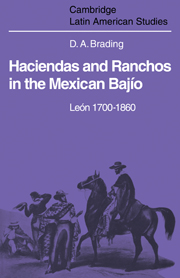Book contents
- Frontmatter
- Contents
- Tables, figures and maps
- Preface
- Measures and Money
- Glossary
- Map 1 The Bajío in the mid nineteenth century
- 1 Introduction: the Mexican hacienda
- 2 The Bajío
- 3 Population
- 4 The structure of agricultural production
- 5 Profits and rents: three haciendas
- 6 Landlords
- 7 Rancheros
- 8 Agricultural prices and the demographic crises
- 9 Epilogue: agrarian reform 1919–40
- APPENDICES
- Archival abbreviations
- Notes
- Bibliography
- Index
- Cambridge Latin American Studies
- Frontmatter
- Contents
- Tables, figures and maps
- Preface
- Measures and Money
- Glossary
- Map 1 The Bajío in the mid nineteenth century
- 1 Introduction: the Mexican hacienda
- 2 The Bajío
- 3 Population
- 4 The structure of agricultural production
- 5 Profits and rents: three haciendas
- 6 Landlords
- 7 Rancheros
- 8 Agricultural prices and the demographic crises
- 9 Epilogue: agrarian reform 1919–40
- APPENDICES
- Archival abbreviations
- Notes
- Bibliography
- Index
- Cambridge Latin American Studies
Summary
At the close of the eighteenth century, it took from four to six days to ride on horseback from Mexico City to Querétaro, still then called ‘the door to the Interior’. But before entering the arid steppelands of the North, the traveller first came to the Bajío, an area which was ‘rich and fertile and very carefully cultivated’. Indeed Alexander von Humboldt, who visited the region in the summer months of 1803, later wrote: ‘In Mexico the plains which stretch from Salamanca to Silao, Guanajuato and the town of León have the best cultivated fields in Mexico and remind one of the most attractive countryside in France.’ Similarly, Joel Poinsett, the first American envoy to Mexico, was surprised to find that ‘the plain which extends from Apaseo to León is full of small cities, villages and farms.’ It is only fair to note, however, that impressions, depended upon the season, since H. G. Ward, who saw the province, in November 1827 after a prolonged drought, confessed his disappointment that ‘the country wore the same dull livery of dust which gives so monotonous a character to the scenery throughout, the Tableland’.
Situated at the very centre of the modern Mexican republic within the states of Guanajuato and Querétaro historically and geographically, the Bajío was a frontier zone, standing between the inhospitable wastelands of the north and the fertile valleys of the central plateau. During the Tertiary Age, the plains had formed a vast lake lined by volcanoes.
- Type
- Chapter
- Information
- Haciendas and Ranchos in the Mexican BajíoLeón 1700–1860, pp. 13 - 38Publisher: Cambridge University PressPrint publication year: 1979
- 1
- Cited by

